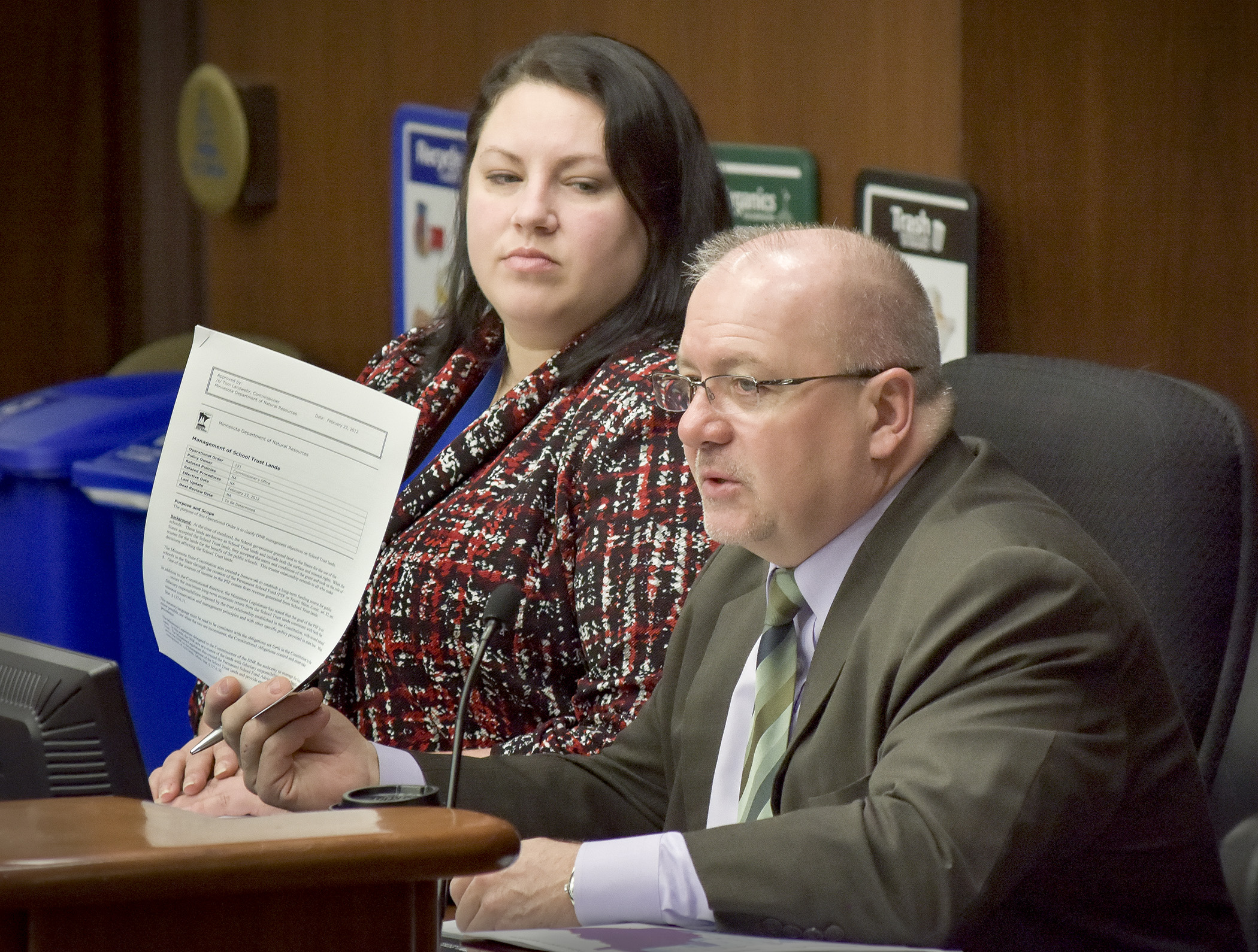Longstanding objections to state-owned lands reemerge
There are 8.5 million acres of state-owned land in Minnesota, and the ongoing debate between those who view that as an asset and those who see it as a threat returned to House Environment and Natural Resources Policy and Finance Committee Wednesday.
Officials from the Department of Natural Resources were on hand to present an overview of the department’s Strategic Land Asset Management plan, which is meant to focus DNR’s work on goals such as consolidation and management efficiency when it buys, sells or exchanges land. No action was taken.
 Assistant Commissioner Bob Meier and Trina Zieman, land asset and school trust administrator, present an overview of the Department of Natural Resources’ strategic land management to the House Environment and Natural Resources Policy and Finance Committee Feb. 1. Photo by Andrew VonBank
Assistant Commissioner Bob Meier and Trina Zieman, land asset and school trust administrator, present an overview of the Department of Natural Resources’ strategic land management to the House Environment and Natural Resources Policy and Finance Committee Feb. 1. Photo by Andrew VonBankHowever, several committee members took the opportunity to voice their objections to the larger issue of state land ownership.
“I have conversations back home with people who are extremely frustrated with the way things are going and the impact this has on their communities,” said Rep. Dan Fabian (R-Roseau), the committee chair.
Much of the state-owned land is in northeastern Minnesota, where there is concern about lost property tax revenue and fewer opportunities for private ownership.
“You’re putting a big burden on the taxpayers,” Rep. Steve Green (R-Fosston) said.
Of the 8.5 million acres the state owns, the DNR manages 5.7 million acres and 2.8 million are under county control. The types of state-owned land (by acres) are:
- Tax forfeited (2.8 million)
- School Trust (2.5 million)
- Acquired (1.58 million)
- Consolidated Conservation (1.55 million)
- Volstead (332,000)
- University Trust (258,000)
Those acquired lands are “the crux” of the argument when people say the state owns too much land, according to Assistant Commissioner Bob Meier.
While the other types of land, such as trust or tax-forfeited, have come under DNR control due to a variety of circumstances, acquired lands are different.
“These are the lands we’ve actually bought, the cream of the crop,” Meier said.
DNR seeks this land out for purchase because of its value for public recreation – hunting land for example – or for the resources it can produce, such as timber sales.
“These land acquisitions, it’s not the DNR that’s driving this,” Meier said. “It’s the citizens out there who want this.”
Although local governments do lose out on property taxes when the DNR buys land, the state reimburses counties millions of dollars for this lost revenue with Payment in Lieu of Taxes. In 2015, the total gross PILT payment was $31.4 million.
“If these public lands weren’t there, counties would be millions and millions of dollars short of their operating budgets,” Meier said.
The state does own some land it would like to sell, however, and Meier said DNR is working to get rid of parcels that don’t provide benefits.
But Fabian wondered why the process for selling land is so lengthy when “in the blink of an eye” the DNR could buy it.
“This is obviously a topic that’s important to me,” Fabian said. “When you look at the maps and how much public land there is in northern Minnesota, we need to tackle this issue in a meaningful way.”
Related Articles
Search Session Daily
Advanced Search OptionsPriority Dailies
Speaker Emerita Melissa Hortman, husband killed in attack
By HPIS Staff House Speaker Emerita Melissa Hortman (DFL-Brooklyn Park) and her husband, Mark, were fatally shot in their home early Saturday morning.
Gov. Tim Walz announced the news dur...
House Speaker Emerita Melissa Hortman (DFL-Brooklyn Park) and her husband, Mark, were fatally shot in their home early Saturday morning.
Gov. Tim Walz announced the news dur...
Lawmakers deliver budget bills to governor's desk in one-day special session
By Mike Cook About that talk of needing all 21 hours left in a legislative day to complete a special session?
House members were more than up to the challenge Monday. Beginning at 10 a.m...
About that talk of needing all 21 hours left in a legislative day to complete a special session?
House members were more than up to the challenge Monday. Beginning at 10 a.m...